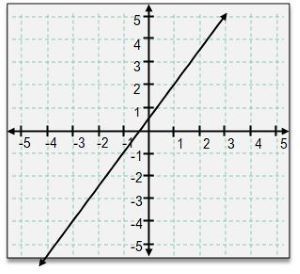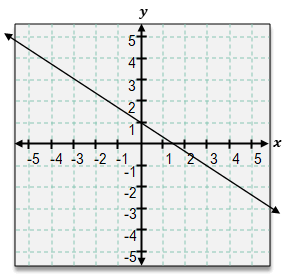Hey, everyone. So, as we've talked about equations with 2 variables, we've seen different shapes of graphs. For example, we've seen perfectly straight lines, but we've also seen things that curve in different ways. Well, for the next few videos, we're only going to be focusing on lines, and we're going to start our discussion by talking about a very important characteristic of lines, which is called the slope. What I'm going to show you in this video is that the slope is really just a number that you can calculate by using any two points on a line. It's very straightforward. Let me go ahead and take a look. Let's go ahead and take a look here.
The slope is really just a number that represents how steep a line is. So take a look at these two lines and imagine they were like the side of a hill that you're trying to climb. The green one is a little more shallow because you don't have to rise as much or go up before you can go over, whereas the red line is a little steeper. It's like a little more vertical. This would be a harder climb. Mathematically, what's going on here is it's how much the y-value changes divided by how much the x-value changes. So let's take a look at the equation here. The variable that we use for the slope is the variable m, and the equation is:
y2 − y1 x2 − x1I'm going to talk about what those things mean in just a second, but this is a little tedious to write out. So we've developed a little bit of a shorthand for this, and we use a little triangle symbol, which is the Greek letter delta. The way that this is written is Δy over Δx just to make it a little more short. And basically, what the Δy means is it's kind of like the rise of an equation or a graph divided by Δx, which is like the run. Again, think about the steepness here and think about these two lines. Imagine I was trying to get from this point to this point. First, on this graph, I have to rise a little bit. I have to go up vertically before I can go over. That's what those delta symbols mean here. Alright? So anytime you see this triangle symbol that just means a change in a variable or a difference. Basically, what's going on here with these y2s and y1s and all that stuff is these are actually just points. So remember that we can locate any point on a graph, which is by an xy pair, But since we have 2 of them, we just give them numbers. And so, really, x2 and y2 are just and x1 and y1 are just 2 points that are on a graph, and they might be given to you, or you might have to pick them yourself. Let's go and take a look at an equation or an example so I can show you how this works.
We're going to find the slopes of these two lines that we've been seeing in this graph. So, basically, what we have to do is to find the slope of a or this yeah. The slope of a. I just need y2 minus y1 over x2 minus x1. So what are those two points over here? Well, here on the graph, they're given to us. We just have to figure out what those ordered pairs are. What are those points x1, y1? So this point over here, I'm going to use this x1, y1, and this is just the point 1, comma, 2. Right? So this is 1, comma, 2. And what's my x2y2? It's just 2 and then 4 in the y. So this is 2, comma, 4. So these are my 2 ordered pairs, and I could plug them into this equation over here and calculate. So y2 is the y-coordinate of the second point, which is 4, minus y1, which is 2, and then x2 minus x1 is the x-coordinate of 2 minus the x-coordinate of 1, so that's 2 minus 1. So what happens here is you just get 2 over 1, and so, therefore, the slope of a is just equal to 2. The rise over the run from this point to this point, my rise is 2. And then what's the run? I went from 1 over to 2 over here. So that means the run is just 1. So in other words, the rise over to run was just 2 over 1, and that's why we got a slope of 2.
Let's do the exact same thing now for points for line b. Alright? So the slope is 2. So for line b, what we're going to do here is we're going to be in x1, y1, and x2, y2. Alright? Now in this case, the actual points aren't given to us already, so we're going to have to go pick them. And, basically, what you want to do here is you always want to pick points that are sort of, like, sit at the, sort of intersection of your grid. You don't want to pick points that are kind of, like, halfway between a point because it's really hard to tell what numbers those are. So these are bad points. You're always going to look for points like this over here or this over here where you can very easily tell what those coordinates are. Alright? So in this case, this is going to be my x1, y1, and that's going to be my x2, y2. Alright? So what are those points? Well, this point over here is really just 4, comma negative one, and this point over here is really just 5, comma 4. Alright? So my x1y1 is 4, comma negative one, and this is just going to be 5, comma 4 over here. So let's use our equation now for the slope. So my MB is really just y2 minus y1 over x2 minus x1, or it's really just Δy over Δx. So let's try to use the rise over the run sort of technique. What's the rise in this equation? How much do I have to go up by before I go over? Well, look at these points. How much do I have to go up? I have to go 1, 2, 3, 4, and 5. So in other words, the Δy over here is 5. And what's the run? Well, I'm really just going from 4 to 5, so the Δx is just 1. Alright? So, really, without having to plug in all these points, you can just figure out that it's just 5 over 1 and the slope of this line is equal to 5. Alright.
So let's take a look at these two numbers now. We got 2 and then we got 5 for the red line. Notice how I said earlier that the green line would be easier because it's a little shallower. Right? It's a little easier climb because it's not as steep, whereas the red line is way more vertical. Basically, what we can see here is that shallower lines have lower slopes, and steeper lines have higher slopes. So a slope of 5 means you have to go up 5 before you can go over 1. Alright? Now one last point I want to make here is actually, you know, we picked these as our x1 y1 and x2 y2, but the order of points actually doesn't matter because it won't affect what your slope is. Generally, what's best to do though is set your x1, y1 as the leftmost points. Basically, just because it's going to introduce the fewest number of negative signs. Let me just show you what I mean by this. We're going to do this last example. We're going to recalculate this slope over here for a, but we're going to reverse the points. So now our x1, y1 is going to be 2, 4, and then our x2, y2 is going to be 1, comma, 2. But we're going to see that the math works just the same way. So our m_a is just going to be:
y2 − y1 x2 − x1Really, just what happens is if we're going to use y2 minus y1, now this becomes 2 minus 4 divided by x2 minus x1, that's 1 minus 2. And what we're going to see here is that we're going to get negative 2 over negative 1. The negatives actually cancel, and you still just end up with a slope of 2. So reversing the points actually doesn't affect the slope, but you just get a few more negative signs, and that's a little harder.
So that's it for this one, folks. Thanks for watching.

















